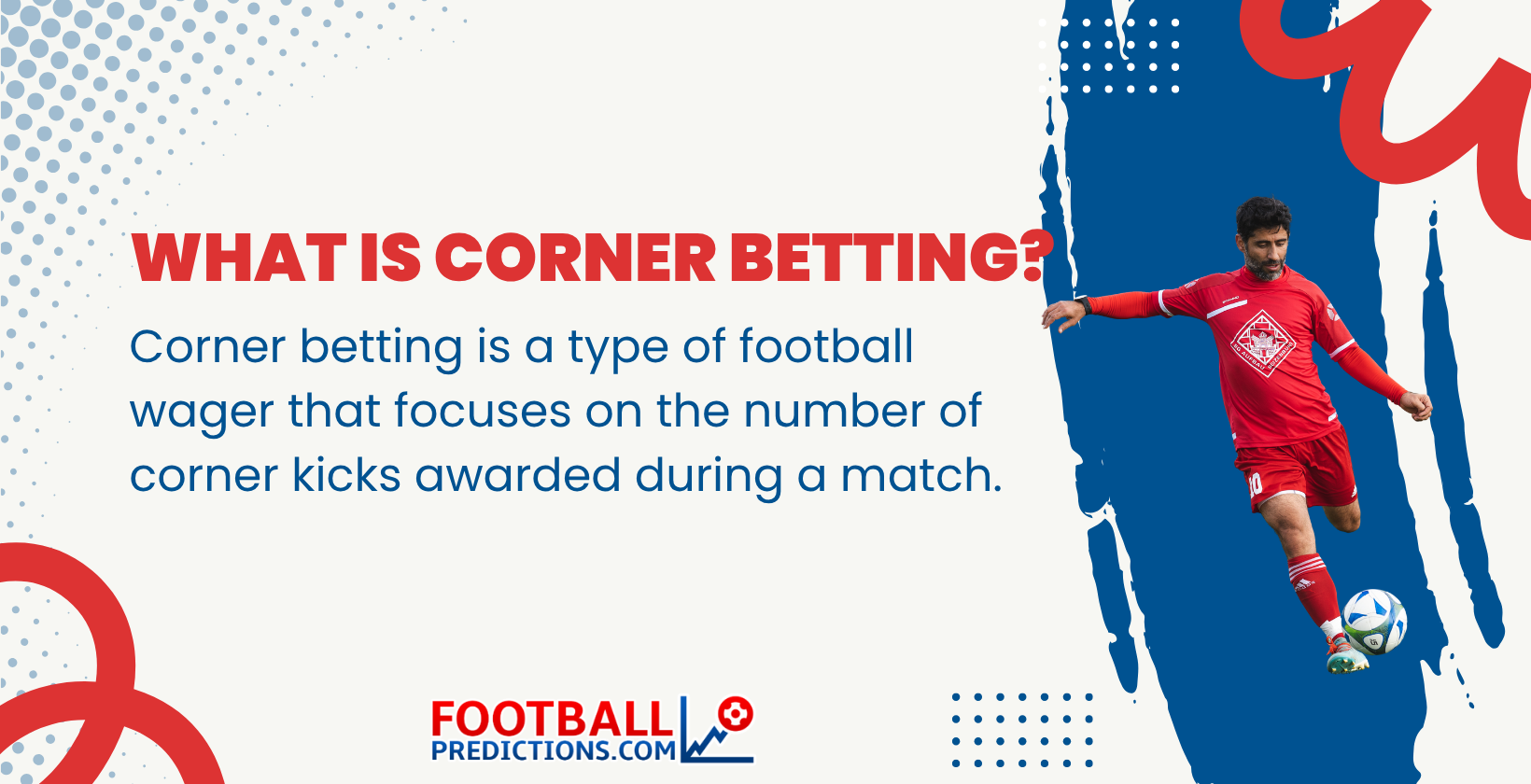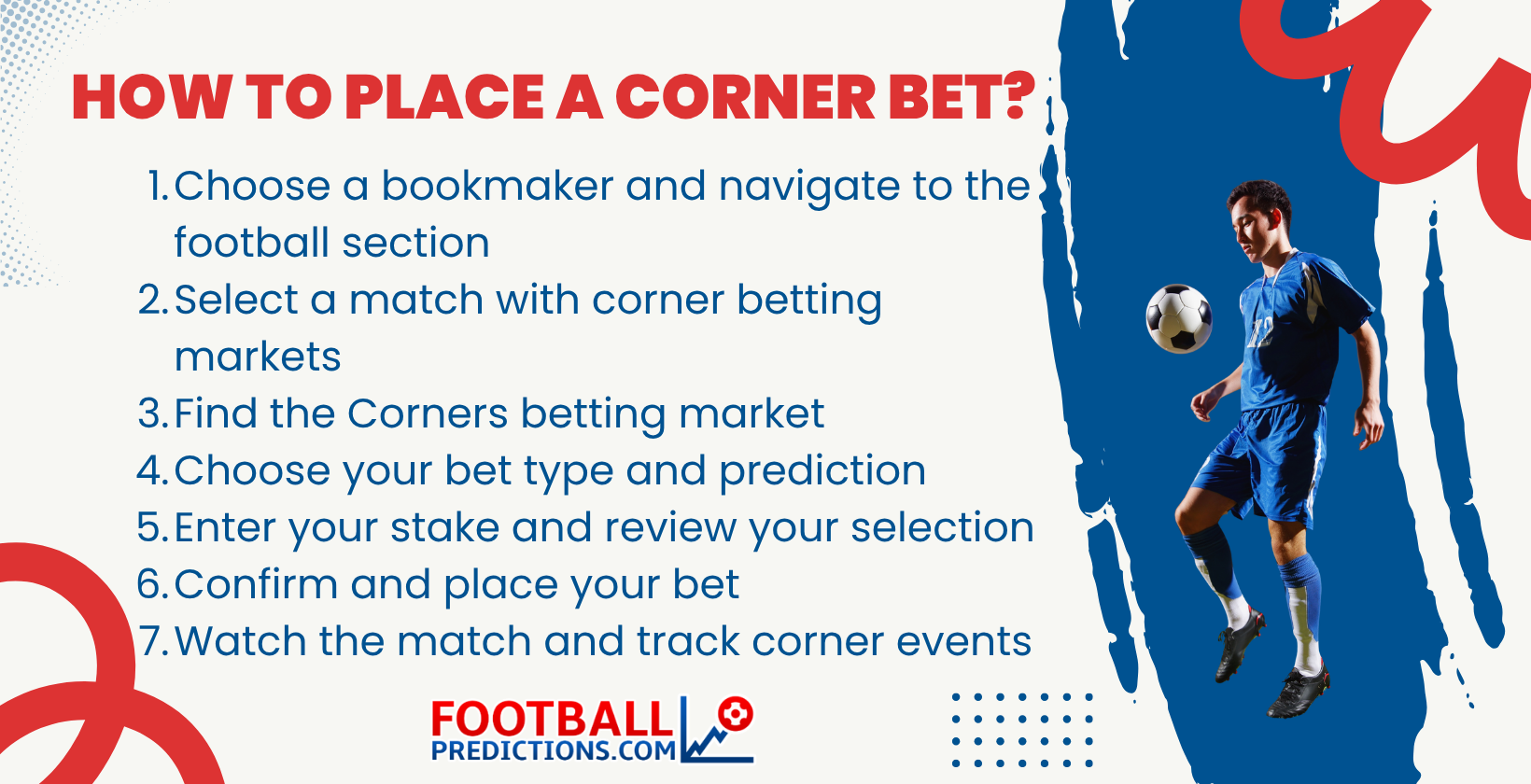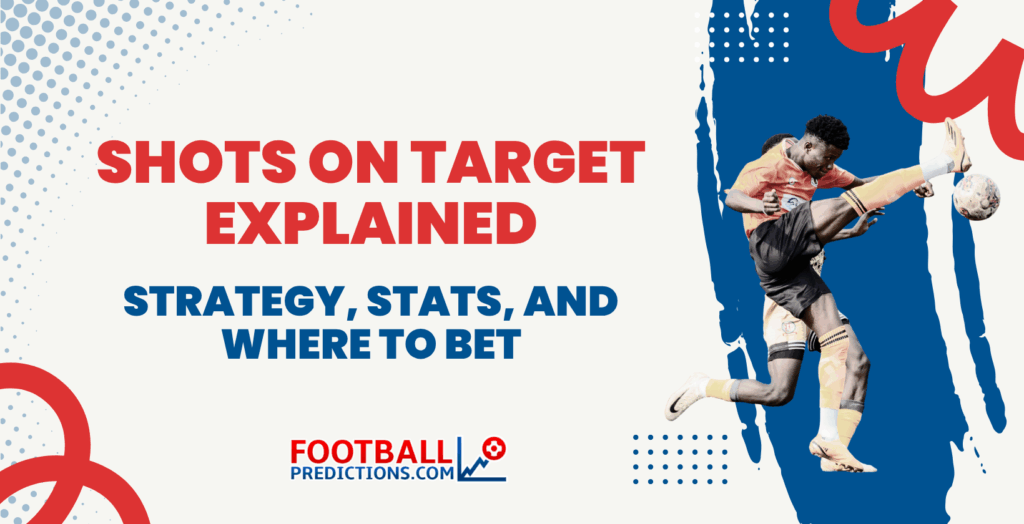Corner Betting Tips and How to Predict Corners

| Match | Total Corners | Odds |
|---|---|---|
| 6 - 8 | 140 | |
| 6 - 8 | 160 | |
| 6 - 8 | 162 | |
| 6 - 8 | 160 |
Corner betting is a football wagering market focused on predicting outcomes related to corner kicks, such as the total number taken, which team earns more, or when they occur. Corner bets, sometimes called “corners bets” outside the UK, have become increasingly popular due to their independence from final match results and the abundance of statistical data they rely on.
Today’s corner tips and predictions are updated daily based on a combination of historical corner statistics, team playing styles, and live match context, helping bettors make informed decisions rather than relying on guesswork. Corner tips are specific betting suggestions, such as backing a team to win the most corners, typically offered for upcoming matches. Corner predictions, on the other hand, refer to forecasted outcomes related to corner kick events, often based on analysis of team tendencies, matchups, and tactical trends.
The corner betting market is more diverse than traditional goal-based bets, offering different corner bet types such as Total Corners, Most Corners, First Match Corner, and First- or Second Half Corners, each suited to different strategies and match dynamics.
To place a corner bet, simply choose a football match from a bookmaker, go to the Corners market, select your preferred bet type (like total corners or first team to five), enter your stake, and confirm your selection to see if it lands during the game.
The best leagues for corner betting are those with high average corner counts and attacking styles of play, including Poland’s I Liga, Scotland’s Premiership, and the English Premier League, with teams like Celtic, Manchester City, and Liverpool often topping corner charts.
Table of Contents
What is Corner Betting?
Corner betting is a type of football wager that focuses on the number of corner kicks awarded during a match. Bettors place predictions based on corner kick totals, corner kick timings, or which team will win the corner count, regardless of the final score.

The corner betting market has gained popularity for offering more control and statistical backing than goals or result-based bets. This is because corners tend to occur more frequently than goals and follow clearer statistical patterns tied to team tactics, possession, and shot volume.
Common options include total corners over/under, corner race (which team reaches a certain number first), and first or last corner. Successful corner betting depends on researching team styles, average corner stats, attacking patterns, and even weather conditions, as these all influence how many corners occur in a game. Like card betting, which involves predicting yellow and red card outcomes, corner bets are an events-based market independent of the final score.
How to place a Corner bet?
Placing a Corner bet is relatively straightforward, involving just 7 simple steps. Start by choosing a football match from a reputable bookmaker, then look for the “Corners” section within the betting markets. You’ll see different options such as total corners over/under, first team to reach a certain number, or which team will take the most corners. Once you’ve selected your market and prediction, add it to your bet slip, enter your stake, and confirm your bet. Finally, all you have to do is watch the match and wait to see if your prediction matches the final outcome for a winning result.
The 7 main steps of making a Corner bet are outlined in detail below.
- Choose a bookmaker and navigate to the football section. Log into your preferred bookmaker’s website or app, such as Bet365 or William Hill, and head to the football section where you’ll find the list of upcoming matches and available markets.
- Select a match with corner betting markets. Pick a fixture that interests you, ideally one where you’ve reviewed stats like average corners per match or team playing styles.
- Find the Corners betting market. Once inside the match page, scroll to locate the Corners section. It often appears as “Total Corners,” “Corner Race,” “First/Last Corner,” or “Team with Most Corners.”
- Choose your bet type and prediction. Decide what you want to bet on. For example, “Over 10.5 Corners,” “Team A to win the corner race to 5,” or “Team B to take the first corner.”
- Enter your stake and review your selection. Click on your chosen outcome, enter the amount you want to bet, and make sure your selection and odds are correct in the bet slip.
- Confirm and place your bet. Once you’ve verified your stake and selection, submit your bet. It will remain active until the end of the match or until the selected corner event occurs.
- Watch the match and track corner events. Keep an eye on the game, especially in the second half when corners usually increase. Your bet will be settled based on whether the corner conditions were met.

What Are the Main Types of Corner Bets?
Corner betting involves predicting specific outcomes related to corner kicks during a football match. The four main types of corner bets include Total Corners, Most Corners, First Match Corner, and First Half/Second Half corners. Each outcome suits different strategies, from reading early match momentum to analysing team possession trends.
More information about the four main types of corner bets follows below.
- Total Corners. Total Corners bets involve wagering on whether the combined number of corners in a match goes over or under a line set by the bookmaker. For example, betting on over 10.5 corners in a Premier League match requires at least 11 corners in total to be scored by both teams combined. This market rewards analysis of average corner stats, expected possession share, and playing styles.
- Most Corners. Most Corners bets involve predicting which team will finish the match with more corners. It functions similarly to result betting and often favours the stronger or more attacking side. Studies show that in over 60% of Premier League fixtures, the match favourite wins the corner count. This market benefits from research into team tactics, expected possession, and offensive patterns.
- First Match Corner. First Match Corner bets are placed on which team will take the first corner of the match. It is a high-variance market that rewards early momentum or aggressive starts, particularly from home teams. Stadium atmosphere, kickoff strategies, and early pressure help shape the outcome.
- First Half or Second Half Corners. First Half or Second Half Corners bets focus on the number of corners awarded during a specific half. Options include totals (such as Over 4.5 First Half Corners) or choosing the team expected to win the corner count during one half. Tactical setups, in-game substitutions, and match tempo often shift between halves, influencing corner volume.
Where can I place a corner bet?
You can place a corner bet with most major online bookmakers such as Bet365, William Hill, Betfair, and Paddy Power. These popular football betting sites include a wide range of corner-related options under each match listing. After selecting a fixture, scroll through the available markets to find sections labelled “Corners,” “Total Corners,” “First Corner,” “Corner Race,” or “Team with Most Corners.” Some betting apps allow custom Bet Builders as well, which allows you to include corners as part of a multi-leg wager. Always check the terms and odds before placing your bet.
What are the Pros and Cons of a Corner Bet?
The rise in popularity of corner betting comes from its focus on corner kick-related outcomes instead of goals or final results, offering a wider range of betting opportunities. As a betting market, corners presents several distinct advantages and disadvantages. Pros include higher-than-average odds, stat-based predictability, and independence from final score. Cons include the need for detailed research, limited availability on some platforms, and the time demands of in-play strategies.
An overview of the top three pros of corner betting is given below.
- Higher Odds on Average. Corner markets frequently offer better odds than traditional bets like match results or Over/Under goals. For example, markets such as “Team to Win Most Corners” often come with generous prices, especially when punters spot mismatches in attacking play or flank use. These odds reflect the greater variance and allow experienced bettors to find value not yet reflected in the lines.
- Stat-Based Predictability. Unlike goals, which depend on precision finishing, corners arise more frequently and somewhat predictably based on team tactics. Teams with strong wing play, frequent shot takers, or dominant possession (e.g., Liverpool, Ajax, or Manchester City) often accumulate more corners. With access to data such as average corners per team or league, punters are able to build informed strategies based on trends rather than guesswork.
- Independence from Final Score. Since corner outcomes are not tied to who wins the match, they remain valuable even in matches with unpredictable results. For example, a team losing 0–3 may continue to push and rack up corners, helping you win your bet even when the scoreboard doesn’t favour them.
A summary of the 3 main cons of corner betting is given below.
- Need for Detailed Research. Corner betting demands a deep understanding of team statistics, playing styles, and formations. Bettors need to track corner averages per match, team tendencies, and game contexts. For example, blindly backing over 10 corners without checking team stats often leads to costly mistakes, especially in slow-paced or defensive leagues.
- Time Commitment for In-Play Success. Live corner betting allows you to place wagers during the match, adjusting your strategy based on real-time events such as pressure buildup, substitutions, or tactical shifts. However, to capitalise on live betting value, you must watch games closely. Effective in-play corner betting involves monitoring minute-by-minute developments, team momentum, and changes in formation. While potentially lucrative, this approach is time-consuming and unsuitable for casual punters.
What Are the Best Leagues and Teams for Corner Betting?
The best leagues and teams for corners betting are those with consistently high corner frequencies and strong attacking or possession-based styles. Leagues that stand out boast average corners per match around 11 or higher, and teams that regularly generate corners, especially via wing play or high possession.
Below are the three best leagues and teams for corner betting based on recent data.
- Poland I Liga – This second-tier Polish league leads global averages with 11.26 corners per match. Matches here often tilt toward corners, making over/under and total-corner markets especially viable.
- Scotland Premiership – Topping the charts at 11.25 corners per match, this league features direct styles and frequent wing attacks. Teams like Celtic consistently hit high corner volumes (≈ 8.7 team average). Domestic competitions such as the Scottish League Cup tend to see strong corner activity, averaging around 10 corners per game in the 2023/2024 season.
- England’s Premier League (Top Tier) – While a step below Poland I Liga and Scotland Premiership, the EPL still averages a solid 10.24 corners per game, with powerhouses like Manchester City (≈ 7.26 corners per match) and Liverpool (≈ 6.6 per match), regularly dominating corner stats.
How to implement a Corner Betting strategy?
Implementing a successful corner betting strategy involves identifying value through statistical comparison, analysing team playing styles and match circumstances, and placing bets at moments of high attacking intensity. When used together, these three elements help produce better predictions and improve long-term returns.
Firstly, identify value by comparing bookmaker lines with actual match data. Most bookmakers set their Over/Under corner lines close to league averages, which usually range around 10 or 10.5 in leagues like the Premier League. Platforms such as Football-Data.co.uk or Corner King provide accurate statistics that reveal where real outcomes regularly differ from bookmaker expectations. For example, some fixtures frequently generate 12 or more corners, yet the line remains set at 10. These gaps suggest opportunities for smarter betting, particularly in lesser-known leagues where pricing tends to follow broad assumptions rather than team-specific trends.
Next, analyse the team and match context to generate insights about viable betting outcomes. Teams with strong wing play, frequent crosses, and high possession (such as Manchester City or Liverpool) typically produce more corners. By contrast, defensive or deep-sitting teams tend to concede more. Yet formations alone are not enough. The situation of the match is crucial. A team trailing late in a match, playing at home in front of an expectant crowd, or fighting to avoid relegation often increases its attacking effort, which leads to more corner situations. Understanding match context sharpens your ability to choose the right matches for betting.
Finally, place bets during high-pressure periods to increase your chances of success. Corner counts tend to rise in the last ten minutes of each half, especially when one side needs to equalise or extend a lead. Experienced bettors often wait until the 35th minute for first-half bets or the 80th minute for second-half markets, when attacking urgency reaches its peak. Monitoring live stats such as possession, shots, and red cards using apps like SofaScore helps detect these shifts in momentum. While pre-match bets based on research remain valid, reacting during play based on real developments gives you more precise control and often better odds.
What Are Corner Tips and Predictions Based On?
Corner tips and predictions are based on historical corner statistics, team playing styles, and live match context. Together, these elements help bettors understand when and why corners are likely to occur, moving beyond guesswork and into informed decision-making.
Historical corner statistics reveal how often teams win or concede corners over time. Metrics such as averages per team, per league, and per match help establish baselines, showing which teams consistently generate high corner counts and which ones rarely do. Comparing a team’s record against similar opponents often reveals patterns that raw averages may overlook.
Team playing styles are another major factor. Sides that dominate possession, use overlapping full-backs, or deliver frequent crosses tend to win more corners. For example, Premier League teams like Manchester City and Liverpool often rank high in both possession and corners won. In particular, Liverpool generates a high volume of corners through their aggressive wing play and frequent deliveries from wide areas, especially via Trent Alexander-Arnold and Andy Robertson. Conversely, teams under sustained pressure tend to concede more corners.
Live match context further sharpens both corner tips and predictions. Corners often surge late in halves, especially when a team is chasing the game or dominating possession. Factors such as red cards, crowd momentum, or attacking substitutions can quickly shift the dynamic and increase corner opportunities. Live tracking via apps like SofaScore allows bettors to react in real time, adjusting their tips or confirming their predictions as corner pressure builds.
When to Avoid Corner Betting?
Avoid corner betting when both teams are evenly matched in strength and playing style. In these cases, neither side tends to dominate possession or create consistent attacking pressure, which usually results in fewer corner kicks. Matches like these often unfold in midfield with limited action near the penalty areas, making it difficult to predict which team will generate more corner opportunities or whether totals will reach the bookmaker’s line.
Another situation where corner betting should be avoided is when the opening minutes of the match show little attacking intent. In matches where the first 10 minutes pass without a single corner, the pace of the game is likely to remain slow. This lack of early aggression usually signals a tactical or cautious approach from both sides, limiting the chance for late surges in corner activity.
Can you use the same research methods for other types of football bets?
Yes, the same research methods used for corner betting apply to other football betting markets. Metrics like expected goals (xG), shot volume, possession share, and wing play influence not only corners but impact markets such as Both Teams to Score (BTTS), Over/Under goals, and First Goalscorer as well. These indicators reveal how often teams attack, where they create chances, and how likely they are to convert them.
Understanding team behaviour and match dynamics is essential across all football betting markets. Using consistent metrics helps improve prediction quality and leads to more reliable football betting tips over time. The same dataset that identifies high-corner fixtures often highlights goal-heavy matches or players likely to score. By tracking tactical patterns, team strengths, and match context, bettors make more accurate selections across different bet types, reducing reliance on luck and increasing long-term success.














